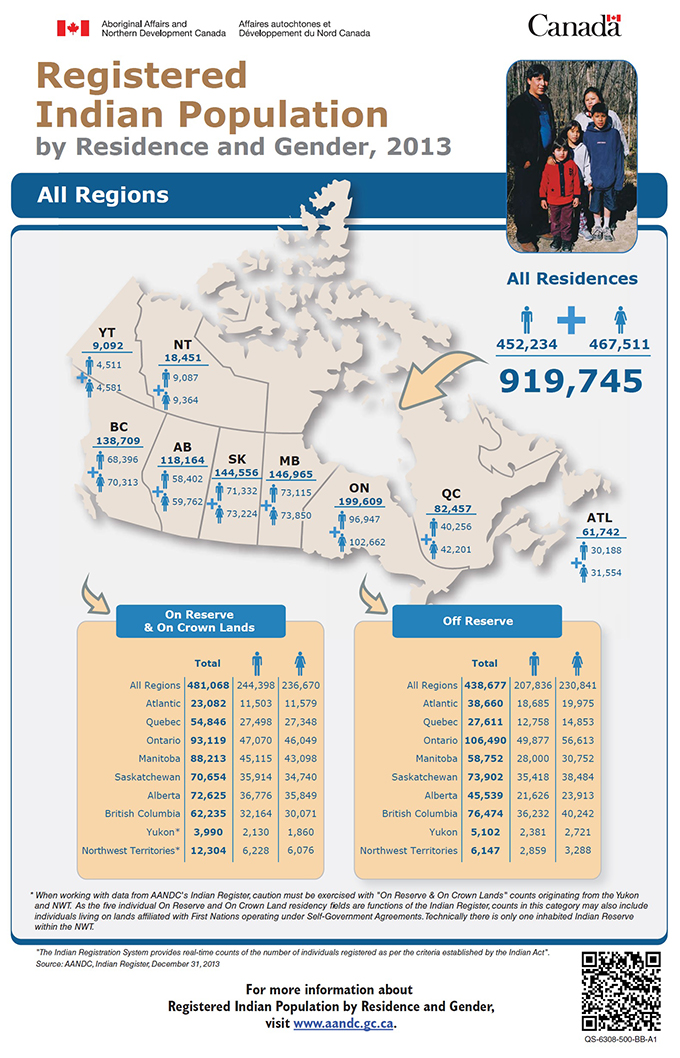Registered Indian Population by Residence and Gender, 2013: Summary Statistics

| AANDC Region | All Residences | On Reserve & Crown Land | Off Reserve | ||||||
|---|---|---|---|---|---|---|---|---|---|
| Total | Male | Female | Total | Male | Female | Total | Male | Female | |
| Canada / All Regions | 919,745 | 452,234 | 467,511 | 481,068 | 244,398 | 236,670 | 438,677 | 207,836 | 230,841 |
| Atlantic | 61,742 | 30,188 | 31,554 | 23,082 | 11,503 | 11,579 | 38,660 | 18,685 | 19,975 |
| Quebec | 82,457 | 40,256 | 42,201 | 54,846 | 27,498 | 27,348 | 27,611 | 12,758 | 14,853 |
| Ontario | 199,609 | 96,947 | 102,662 | 93,119 | 47,070 | 46,049 | 106,490 | 49,877 | 56,613 |
| Manitoba | 146,965 | 73,115 | 73,850 | 88,213 | 45,115 | 43,098 | 58,752 | 28,000 | 30,752 |
| Saskatchewan | 144,556 | 71,332 | 73,224 | 70,654 | 35,914 | 34,740 | 73,902 | 35,418 | 38,484 |
| Alberta | 118,164 | 58,402 | 59,762 | 72,625 | 36,776 | 35,849 | 45,539 | 21,626 | 23,913 |
| British Columbia | 138,709 | 68,396 | 70,313 | 62,235 | 32,164 | 30,071 | 76,474 | 36,232 | 40,242 |
| Yukon | 9,092 | 4,511 | 4,581 | 3,990 | 2,130 | 1,860 | 5,102 | 2,381 | 2,721 |
| Northwest Territories | 18,451 | 9,087 | 9,364 | 12,304 | 6,228 | 6,076 | 6,147 | 2,859 | 3,288 |
| Source: AANDC, Indian Register, December 31, 2013 | |||||||||
For detailed information by individual First Nations, please contact INSTAT@aadnc-aandc.gc.ca
Notes:
These counts were extracted from AANDC's Indian Registration System (IRS) as at December 31, 2013, and have not been adjusted for late reporting of births or deaths. Furthermore, they reflect residency codes for individuals affiliated with AANDC recognized First Nations only. As such, on reserve numbers for each Region should not be taken to represent the true population for the following reasons:
- They contain no information on any Non-Registered individuals who may be living on reserve or crown lands,
- They contain no information on any individuals registered with bands from outside the region who may be living on reserve or crown lands within the region, and
- Since "On Reserve & Crown Land" is a roll-up of residency fields 1 through 5, they may include counts pertaining to registrants affiliated to First Nations from within the region, but residing on reserve or crown lands belonging to other bands administered outside the region.
- In the Yukon, the 'On Reserve & Crown Land' category includes individuals living on lands affiliated with First Nations operating under Self-Government Agreements.
Limitations on IR Data
An individual's information on the IRS is usually updated on the reporting of a life event to the First Nation's Indian Registry Administrator (IRA), although some bands may update the system more frequently. Perhaps the greatest limitation on Indian Register data involves the late reporting of these life events. According to recent history, about 70% of all births reported in any particular year actually occurred in a prior year. This is not out of the ordinary since it is common practice for children to be registered between the ages of 1 to 5. Besides births, individuals can remain on the Indian Register for some time after they are deceased. A certificate of death or a confirmation of presumed death is normally required to remove a name from the system.
A second major limitation involves residency codes. Similar to life events, residency codes tend to be updated by the IRA when a life event is reported (although some bands may again update the system more frequently). This makes it possible for an individual to move back and forth between on and off reserve, and never have his/her information updated if a life event was not reported. Furthermore, the residency field is optional when the IRA updates the system.
Prepared by: Statistics and Measurement Directorate (SMD), Feb 10, 2014